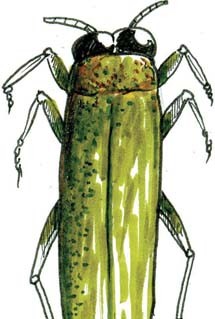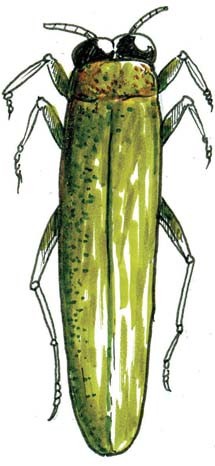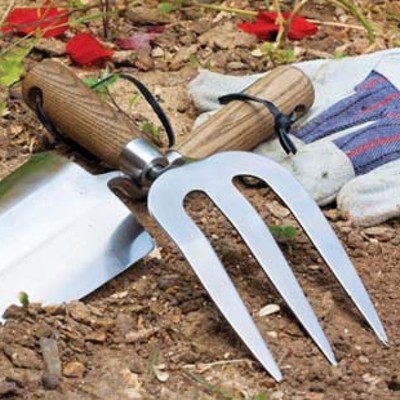The Illinois Department of Agriculture announced on July 18 that the emerald ash borer had been spotted in McLean County. In the past six years this pest has killed millions of ash trees in Ohio, Indiana, Maryland, West Virginia, Pennsylvania, and Michigan, as well as Ontario, Canada. Since the emerald ash borer began knocking at our back door we've received several calls from anxious homeowners and gardeners.
Here are answers to some basic questions.
What tree species does the emerald ash borer attack? This destructive nonnative pest (Agrilus planipennis)feeds only on North American ash species (Fraxinus sp.). White ash and green ash trees are common in Illinois. Blue ash, black ash, and pumpkin ash are other true ashes that are not as common. The pest does not attack the mountain ash, which is not a true ash species.
How do I recognize an ash tree? An ash tree can be identified by opposite pinnately compound leaves. Each leaf is made up of five to nine glossy dark-green leaflets. The bark of a young ash is usually flaky; mature ash trees have light-gray to gray-brown bark with ridges and deep furrows forming diamond-shaped areas. For more information, visit the Ohio State University Web page "Are My Trees Ash?" at www.ohioline.osu.edu/for-fact/0055.html.
What are the signs of infestation? Signs of emerald ash borer infestation include the presence of the adult metallic-green beetle on or around ash trees, thinning and yellowing leaves, 1/8-inch-diameter D-shaped holes (about the size of a BB) in the bark of the trunk or branches (usually starting at the top of the tree), and shoots growing from the base of the tree (known as epicormic shoots). Other symptoms include dieback that begins in the upper third of the tree and progresses downward, serpentine (S-shaped) tunnels just beneath the bark, vertical splits in the bark, and increased woodpecker activity. An infested tree may not show physical signs of damage for two years.
What does the emerald ash borer look like? The adult emerald ash borer is a small metallic-green beetle, 3/8 to 5/8 inch long and 1/16 inch wide. The adult feeds on ash foliage but causes little damage to the leaves. It attacks both healthy and stressed ash trees. Emerald ash borer larvae feed on the inner bark of ash trees. The tunnels made by the feeding larvae cut off the flow of nutrients and water between the tree's roots and canopy, thereby starving the tree. The larvae — flat, legless, heavily segmented, and creamy white — grow to about 1 inch in length.
Are there insects that look similar to the emerald ash borer? Several metallic green insects are found in central Illinois. Adult bronze birch borers, similar but darker-colored beetles, leave D-shaped holes in stressed birch trees. Japanese beetles, which are actively devouring plants in this area right now, are about 1/2 inch long, metallic green with coppery brown wing covers.
What are other problems of ash trees? Before jumping to the conclusion that your ash tree is
infested with emerald ash borers, keep in mind that ash trees in Illinois
are vulnerable to several insect and disease problems, as well as
environmental factors that can cause similar symptoms. Ash/lilac borer is a
common native pest of ash trees. This wasp-mimicking moth leaves 1/4-inch
round holes on emerging from a tree. Sapsuckers also create holes in trees.
The round holes are found in uniform rows up and down a tree's trunk.
Common ash diseases include ash yellows, anthracnose, verticillium wilt,
and cankers. "Ash decline" is a term used to describe the
overall decline of an ash tree; other causes of decline include
stem-girdling roots and environmental stress brought on by drought,
mechanical injury, or salt damage.
How can I help prevent the spread of this pest? The emerald ash borer adult can fly, which slowly spreads the infestation, but human beings contribute to its rapid spread. Several infestations have been traced to the transport of firewood from affected locations. It is unsafe and in most locations illegal to transport ash firewood from a quarantine zone; unseen but harmful tree pests may lurk in the wood. To avoid the accidental introduction of emerald ash borer and other harmful pests, you should purchase only locally grown nursery stock and locally cut firewood.
For information on the proper identification of an ash tree, photos of the emerald ash borer, and other problems of ash trees, visit www.emeraldashborer.info.
If you have additional questions, contact your local University of Illinois Extension office. In Sangamon and Menard counties, call 217-782-4617.
Jennifer Fishburn is a horticulture educator with the University of Illinois Extension Sangamon-Menard Unit. Contact her at [email protected].






















